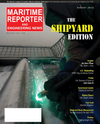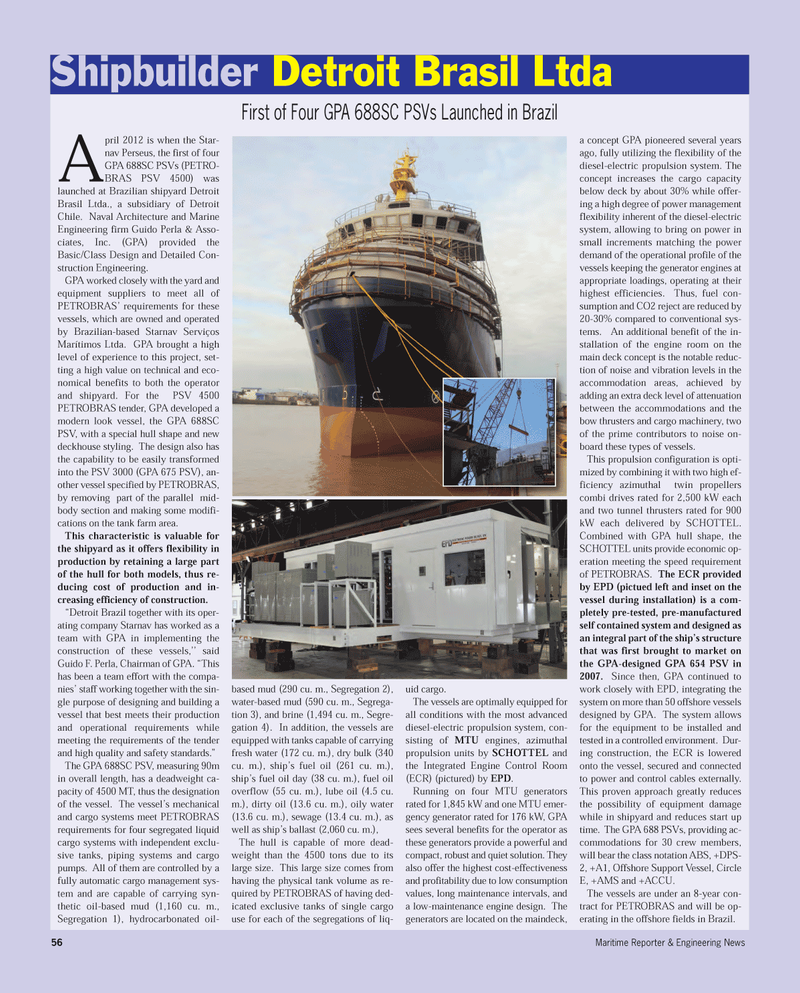
Page 56: of Maritime Reporter Magazine (August 2012)
The Shipyard Edition
Read this page in Pdf, Flash or Html5 edition of August 2012 Maritime Reporter Magazine
56Maritime Reporter & Engineering News ShipbuilderDetroit Brasil Ltda April 2012 is when the Star- nav Perseus, the first of four GPA 688SC PSVs (PETRO- BRAS PSV 4500) was launched at Brazilian shipyard Detroit Brasil Ltda., a subsidiary of DetroitChile. Naval Architecture and Marine Engineering firm Guido Perla & Asso- ciates, Inc. (GPA) provided the Basic/Class Design and Detailed Con-struction Engineering. GPA worked closely with the yard and equipment suppliers to meet all ofPETROBRAS? requirements for these vessels, which are owned and operated by Brazilian-based Starnav Serviços Marítimos Ltda. GPA brought a high level of experience to this project, set- ting a high value on technical and eco- nomical benefits to both the operator and shipyard. For the PSV 4500 PETROBRAS tender, GPA developed a modern look vessel, the GPA 688SC PSV, with a special hull shape and new deckhouse styling. The design also has the capability to be easily transformedinto the PSV 3000 (GPA 675 PSV), an- other vessel specified by PETROBRAS, by removing part of the parallel mid- body section and making some modifi- cations on the tank farm area. This characteristic is valuable for the shipyard as it offers flexibility inproduction by retaining a large part of the hull for both models, thus re- ducing cost of production and in- creasing efficiency of construction. ?Detroit Brazil together with its oper- ating company Starnav has worked as a team with GPA in implementing the construction of these vessels,?? said Guido F. Perla, Chairman of GPA. ?This has been a team effort with the compa- nies? staff working together with the sin- gle purpose of designing and building a vessel that best meets their production and operational requirements whilemeeting the requirements of the tenderand high quality and safety standards.? The GPA 688SC PSV, measuring 90m in overall length, has a deadweight ca- pacity of 4500 MT, thus the designation of the vessel. The vessel?s mechanical and cargo systems meet PETROBRAS requirements for four segregated liquid cargo systems with independent exclu- sive tanks, piping systems and cargo pumps. All of them are controlled by a fully automatic cargo management sys- tem and are capable of carrying syn-thetic oil-based mud (1,160 cu. m.,Segregation 1), hydrocarbonated oil- based mud (290 cu. m., Segregation 2), water-based mud (590 cu. m., Segrega- tion 3), and brine (1,494 cu. m., Segre- gation 4). In addition, the vessels are equipped with tanks capable of carryingfresh water (172 cu. m.), dry bulk (340 cu. m.), ship?s fuel oil (261 cu. m.), ship?s fuel oil day (38 cu. m.), fuel oil overflow (55 cu. m.), lube oil (4.5 cu. m.), dirty oil (13.6 cu. m.), oily water (13.6 cu. m.), sewage (13.4 cu. m.), as well as ship?s ballast (2,060 cu. m.), The hull is capable of more dead-weight than the 4500 tons due to itslarge size. This large size comes from having the physical tank volume as re- quired by PETROBRAS of having ded- icated exclusive tanks of single cargo use for each of the segregations of liq- uid cargo. The vessels are optimally equipped for all conditions with the most advanced diesel-electric propulsion system, con-sisting of MTUengines, azimuthalpropulsion units by SCHOTTEL andthe Integrated Engine Control Room (ECR) (pictured) by EPD. Running on four MTU generatorsrated for 1,845 kW and one MTU emer- gency generator rated for 176 kW, GPA sees several benefits for the operator as these generators provide a powerful and compact, robust and quiet solution. They also offer the highest cost-effectiveness and profitability due to low consumption values, long maintenance intervals, and a low-maintenance engine design. The generators are located on the maindeck,a concept GPA pioneered several years ago, fully utilizing the flexibility of the diesel-electric propulsion system. The concept increases the cargo capacity below deck by about 30% while offer- ing a high degree of power management flexibility inherent of the diesel-electric system, allowing to bring on power in small increments matching the power demand of the operational profile of the vessels keeping the generator engines at appropriate loadings, operating at theirhighest efficiencies. Thus, fuel con- sumption and CO2 reject are reduced by20-30% compared to conventional sys- tems. An additional benefit of the in- stallation of the engine room on themain deck concept is the notable reduc-tion of noise and vibration levels in the accommodation areas, achieved by adding an extra deck level of attenuation between the accommodations and thebow thrusters and cargo machinery, two of the prime contributors to noise on- board these types of vessels. This propulsion configuration is opti- mized by combining it with two high ef- ficiency azimuthal twin propellers combi drives rated for 2,500 kW each and two tunnel thrusters rated for 900 kW each delivered by SCHOTTEL. Combined with GPA hull shape, the SCHOTTEL units provide economic op- eration meeting the speed requirementof PETROBRAS. The ECR provided by EPD (pictued left and inset on thevessel during installation) is a com- pletely pre-tested, pre-manufactured self contained system and designed asan integral part of the ship?s structure that was first brought to market on the GPA-designed GPA 654 PSV in 2007. Since then, GPA continued to work closely with EPD, integrating the system on more than 50 offshore vessels designed by GPA. The system allows for the equipment to be installed andtested in a controlled environment. Dur- ing construction, the ECR is lowered onto the vessel, secured and connected to power and control cables externally. This proven approach greatly reduces the possibility of equipment damagewhile in shipyard and reduces start up time. The GPA 688 PSVs, providing ac- commodations for 30 crew members, will bear the class notation ABS, +DPS- 2, +A1, Offshore Support Vessel, Circle E, +AMS and +ACCU. The vessels are under an 8-year con- tract for PETROBRAS and will be op- erating in the offshore fields in Brazil. First of Four GPA 688SC PSVs Launched in Brazil MR#8 (50-57):MR Template 8/9/2012 10:09 AM Page 56

 55
55

 57
57
